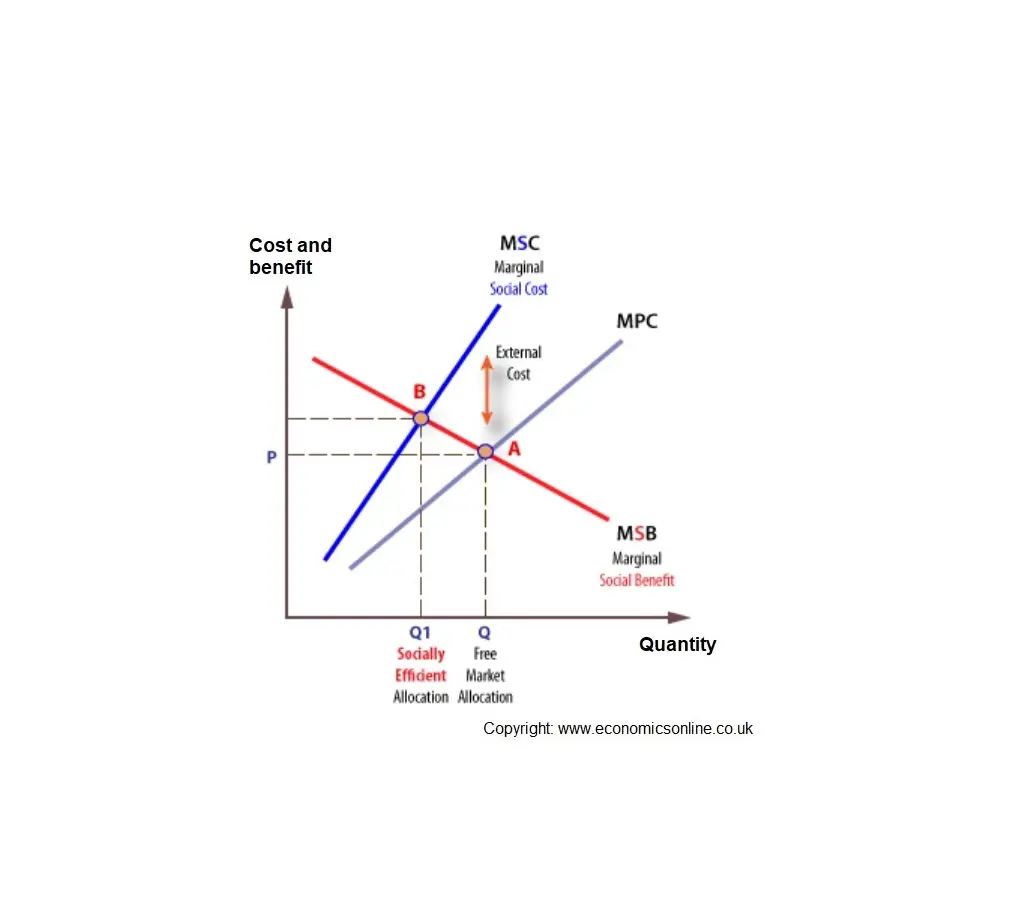
Negative externalities
A negative externality is a cost that is suffered by a third party as a consequence of an economic transaction. In a transaction, the producer and consumer are the first and second parties, and third parties include any individual, organisation, property owner, or resource that is indirectly affected. Externalities are also referred to as spillover effects, and a negative externality is also referred to as an ‘external cost’.
Some externalities, like waste, arise from consumption while other externalities, like carbon emissions from factories, arise from production.
Externalities commonly arise in situations where property rights over assets or resources have not been allocated, or are uncertain. For example, no one owns the oceans and they are not the private property of anyone, so ships may pollute the sea without fear of being taken to court. The importance of establishing property rights is central to the ideas of influential Peruvian economist, Hernando De Soto, De Soto has widely argued that successful market economies need a widespread allocation of property rights to enable them to fully develop.
Showing negative production externalities
An external cost, such as the cost of pollution from industrial production, makes the marginal social cost (MSC) curve higher than the private marginal cost (MPC).

The socially efficient output is where MSC = MSB, at Q1, which is a lower output than the market equilibrium output, at Q.
Net welfare loss
Net welfare loss can exist in two situations. Firstly, it exists when the marginal cost to society of a particular economic activity, such as manufacturing 200,000 computers, is greater than the marginal benefit to society. Secondly, it can exist when the marginal benefit of a given economic activity, such as producing 50,000m computers, is greater than the marginal cost.

The first situation can occur when the market produces ‘too much’, and the second when it produces ‘too little’.
Example
For example, If we consider a manufacturer of computers which emits pollutants into the atmosphere, the free market equilibrium will occur when marginal private benefit = marginal private costs, at output Q and price P. The market equilibrium is at point A. However, if we add external costs, the socially efficient output is Q1, at point B.

At Q marginal social costs (at C) are greater than marginal social benefits (at A) so there is a net loss. For example, if the marginal social benefit at A is £5m, and the marginal social cost at C is £10m, then the net welfare loss of this output is £10m – £5m = £5m. In fact, any output between Q1 and Q creates a net welfare loss, and the area for all the welfare loss is the area ABC.
Therefore, in terms of welfare, markets over-produce goods that generate external costs.
Remedies
Market Based Solutions:
Market-based solutions try to manipulate market forces to reduce the externality, by exploiting the price mechanism. One such market-based solution is to extend property rights so that third parties can negotiate with those individuals or organisations that cause the externality. British economist and Nobel Prize winner, Ronald Coase argued that the establishment of property rights would provide an efficient solution to the problem of externalities. As long as one party can establish a property right, there will be a bargaining process leading to an agreement in which externalities are taken into account.
If property rights cannot be established, such as with the air, sea, or roads, then the only two options are:
- We learn to live with externalities, or:
- Government intervenes on our behalf through taxes or direct controls and regulations, such as:
- Taxing polluters, such as carbon taxes, or taxes on plastic bags.
- Subsidising households or firms to be non-polluters, such as giving grants for home insulation improvements.
- Selling permits to pollute, which may become traded by the polluters.
- Forcing polluters to pay compensation to those who suffer, such as making noise polluting airports pay for double-glazing.
- Road pricing schemes, such as the Electronic Road Pricing (ERP) system in Singapore, which is a pay-as-you-go, card-based, road-pricing scheme.
- Providing more information to consumers and producers, such as requiring that tickets to travel on polluting forms of transport, especially air travel, should contain information on how much CO2 pollution will be created from each journey.
- The adoption of policies emerging from research by behavioural economists – often shortened to ‘nudge’ theory. This type of approach looks at influencing choices individuals make by nudging them towards more effective decison making.
Negative consumption externalities
When certain goods are consumed, such as demerit goods, negative effects can arise on third parties. Common example include cigarette smoking, which can create passive smoking, drinking excessive alcohol, which can spoil a night out for others, and noise pollution.
For example, if an individual plays very loud music in their house they are likely to reduce the benefit to their neighbours of owning the house and living in it.
Another important example of a negative consumption externality if that of road congestion. As individuals ‘consume’ road-space they reduce available road-space and deny this space to others.
Trends in alcohol consumption
As the table indicates, consumption of alcohol (in the UK) has declined in recent years, with a reduction in the percentage of people regularly consuming alcohol falling from 64% to 57% between 2005 and 2016.
See: demerit goods


